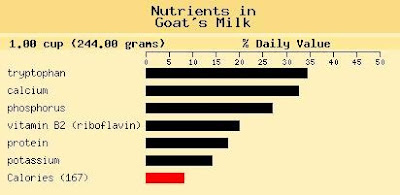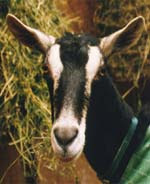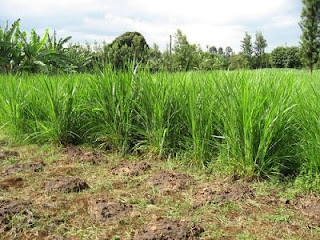Raising meat goats and Boer goats presents a variety of goat care and goat health issues and specific goat diseases that must be avoided, or controlled. The following are the primary ones to consider. All goat herders must be constantly vigilant for signs of disease and subsequent economic losses.
Some diseases can be transmitted to humans from animals. Most of these can be prevented by good hygiene and are mainly caused by not taking sufficient care when handling carcases or of handling placenta and foetuses. A good reference document for most goat diseases is the "Australian Goat Notes" published by the Australian Cashmere Growers Association.
Some typical signs that one of your goats may not be well are as follows:
1. Look for goats that are well away from the main herd, and possibly not eating, or having an abnormal body posture, such as a head hanging down, as these should be suspect. Goats separate only for illness or kidding
2. Always observe faeces, if the droppings are clumping together, or goat is scouring (diarrhea) or the droppings are very hard, then something may be wrong.
3. Always look at the herd for goats that lag behind or have problems keeping up with the herd.
4. Observe the goats’ feet and legs for signs of swelling.
5. Look for sudden or inexplicable weight loss in animals.
6. Look for signs of swelling underneath the chin, which might indicate internal parasites, or lack of specific Vitamins or minerals (e.g. iodine).
7. Look for any abnormal gait that could be staggering, limping or abnormal walking.
8. Look for any dull and rough coats that may indicate underlying disease or deficiencies.
9. Look for abnormal discharges such as blood, mucus and pus from the mouth, eyes, ears or vulva, or any other part of the goat’s body.

Internal Parasites
There are a number of stomach and intestinal worms that affect goats and include:
- Barbers pole worm
- Black scour worm
- Brown stomach wormTape worm
- Liver fluke
- Stomach fluke
- Small lung worm
Nodule worm
Thin necked intestinal worm
Worms can be classified into three main types which correspond to the mechanism they use to cause ill health. They are:
- Blood sucking
- Damage to the gut lining
- Migration through tissue
- Chemical – the use of drenches
- External Parasites
· There are a number of external parasites which can impact on goat health and production. One of the most common of these are lice. There are two types of lice affecting goats. The “blue” or sucking lice that feed on the blood of the animal and four “red” species or biting lice that feed on the surface tissue and scurf.
· The sucking lice will cross infect both goats and sheep. The biting lice are breed specific.

DRENCHING
Developing a Drenching Program
Drenches (anthelminics) are only one part of what MUST be an integrated approach to worm control on any farm. Factors such as drench resistance, worm monitoring and grazing management are also necessary.
Many farmers run goats as well as sheep on their properties, often with the assumption that the two species can be handled in the same way. The use of any product not specifically registered for goats can only be done following the approval of a veterinarian.
There are few drenches recommended for goats and the use of sheep drenches which are not registered for Goats will impact on your National Vendor Declaration (NVD) when selling your animals and should only be used under Veterinary supervision. The most recent release of the specific goat drench – Caprimec by Virbac Animal Health, ensures now that there is a highly effective drench specifically for goats.
Goats tend to become stressed more easily than sheep, particularly goats which have had minimal handling. This is particularly evident when pushing goats into a drenching race. The animals can become very stressed and can suffocate each other.
A goat with worms is not a productive goat, weight loss, scours and death can occur in affected animals.
An effective drenching program leads to healthier goats, less worms on pastures to be passed onto another animals, drenches remain effective for longer and there is a reduced risk of resistance.
Effective Drenching
Only use the correct dose as detailed on the instruction for use sheet on the drench container. DO NOT guess the weight of an animal as under drenching can lead to drench resistance. Draft goats into different groups by weight allowing approximately a range of 10kg in the groups i.e 20-30kg, 31-40 kg etc.
Use a standard sheep drench gun. Place the tip of the gun over the tongue. Goats vocalize when being handled which increases the risk to the drench entering their lungs rather than down the oesophagus.
Drench Resistance / Faecal Egg Counts
As part of an effective drenching program, testing that your drench is effective is essential and will reduce the risk of drench resistance.
The process known as faecal egg count (FEC) will help you determine your parasite burden and the effectiveness of your drench. FEC can be done by yourself or once you have collected the sample sent as a Veterinary Laboratory for a result.
Goat Digestive Physiology
Goats, like cattle and sheep are ruminants, which basically means they have a four chambered stomach. The four chambers are the rumen (approximately 30% of the stomach mass), the reticulum, the omasum and the abomasum (approximately 70% of the stomach mass).
The digestive process starts with taking food into their mouths. The food is ground, chewed and mixed with saliva in the mouth. The "cud" enters the oesophagus and with muscular movement pushed down to the rumen. The microbes in the rumen break down the food from there it passes to the omasum where water and volatile fatty acids are absorbed. From there it passes to the abdomen where the “cud” (food) is digested by hydrochloric acid, as it does in humans.
From the abomasum, the end products move through the small intestine and then the large intestine where they are excreted as dung.







